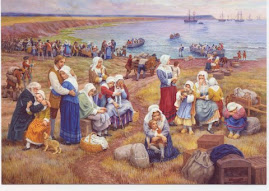 MI'KMAQ FRIENDS AND NEIGHBOURS
MI'KMAQ FRIENDS AND NEIGHBOURSContinuation; of, PORT- LA- JOYE- FORT AMHERST
The Mi'Kmaq moved seasonally and their territory stretched from Cape Breton Island to the Gaspe Peninsula, including Prince Edward Island, Nova-Scotia, and much of New-Brunswick, As friends and allies to the French, the Mi'kmaq helped the early settlers adjust to the harsh winters and to withstand British Attacks.
Under French influence, some Mi'kmaq established a permanent village at Malpeque ( Malpec ) on the north west coast of the Island.
Each year during the French regime, there was an annual gathering of the Mi'kmaq at Port la Joye, Leaders and Elders came from parts of what are now Nova-Scotia and New- Brunswick, as well as from the Island, to renew their alliance with the French,.
Part of the gathering included a gift exchange as the French officials recognized the help the Mi'kmaq were providing,
Today there is still a Mi'kamq community at Rocky Point, adjacent to Port-la-Joye-Fort Amherst. National Historic Site.
THE STRUGGLE FOR POSSESION
After the fall of Fortress of Louisbourg in June of 1745 by New-Englanders, they arrived to take possession of the Island,,, burning Trois Rivieres and Port la Joye.
Between 1745 and 1748 Isle Saint Jean was nominally under British rule. With the treaty at Aix-la-Chapelle, the Island was returned to French rule, and the next decade was a time of rebuilding.
During this time, Isle Saint Jean received many refugee Acadians from the mainland, increasing the Island's population to an estimated 4000. in 1758, the British took possession of Isle Saint Jean for the last time, and the British regime began.
FORT AMHERST
In 1758, Colonel Lord Andrew Rollo arrived at Port la Joye to issue terms of the take-over to the French Commandant.
A fort was erected on the same bluff as the former French capital and named Fort Amherst after Major General Lord Jeffery Amherst, commander of the British Forces in North America.
Following the British take over, Lord Rollo used part of his force of 500 to collect an estimated 3,500 Acadians and bring them to Port la Joye to be deported "Back" to France ( Many of these Acadians had never known France to be their home ) Some Acadian families, as in the past, received help from the native Mi'kmaq to escape the deportation. Others escaped the deportation by fleeing to the mainland, Many of the Acadians living on the Island today descend from those Acadians who fled but came back in the years that followed ( 1760 to 1790s )
TODAY,
Although the earthworks are the only visible reminder of the struggles of the past,
Port la Joye- Fort Amherst National Historic site remains a special place where one can feel the courageous and determined spirits of our ancestors.
May They All Rest In Peace.


